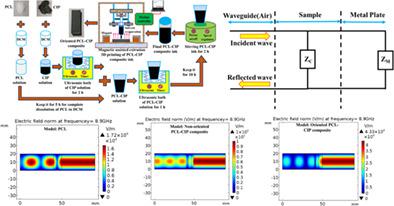当前位置:
X-MOL 学术
›
J. Vinyl Addit. Technol.
›
论文详情
Our official English website, www.x-mol.net, welcomes your
feedback! (Note: you will need to create a separate account there.)
Finite element modeling of electromagnetic properties of 3D printed materials in X-band spectrum
Journal of Vinyl and Additive Technology ( IF 3.8 ) Pub Date : 2021-06-16 , DOI: 10.1002/vnl.21838 Usharani Rath 1 , Pulak M Pandey 1
Journal of Vinyl and Additive Technology ( IF 3.8 ) Pub Date : 2021-06-16 , DOI: 10.1002/vnl.21838 Usharani Rath 1 , Pulak M Pandey 1
Affiliation

|
Microwave absorbers are distinctive class of materials, which are used to absorb undesired electromagnetic waves in the microwave spectrum. A finite element modeling approach was utilized in the present study to investigate the microwave absorption properties of three different materials such as polycaprolactone (PCL) polymer, polycaprolactone-carbonyl iron particle (CIP) composite with random orientation of CIPs, and polycaprolactone-carbonyl iron particle composite with oriented chain structures of CIPs, fabricated by extrusion-based 3D printing process. A two-dimensional model was formulated comprising the material under test and two rectangular waveguides attached to the vector network analyzer. A two-port network model was used to emulate the real-time experimental environment. It was found from the electric field distribution plot that the oriented PCL-CIP model reflects and transmits marginal amplitude of electromagnetic waves when compared with nonoriented PCL-CIP model followed by pure PCL model. The simulation results were validated with the experimental findings. A minimum loss of electromagnetic energy was observed for oriented model as compared to other models, supporting the experimental findings. Larger domain wall motions and micro capacitor behavior of oriented chains of carbonyl particles were responsible for such microwave absorption properties of oriented composites. The practical utility of the present modeling and simulation approach is multifold as it can be utilized to investigate and compare the electromagnetic shielding behavior of various polymeric composites without any material wastage, machine utilization, and physical testing.
中文翻译:

X 波段频谱中 3D 打印材料电磁特性的有限元建模
微波吸收器是一类独特的材料,用于吸收微波频谱中不需要的电磁波。本研究利用有限元建模方法研究了三种不同材料的微波吸收特性,例如聚己内酯 (PCL) 聚合物、具有随机取向的 CIP 的聚己内酯-羰基铁颗粒 (CIP) 复合材料和聚己内酯-羰基铁颗粒通过基于挤出的 3D 打印工艺制造的具有 CIP 定向链结构的复合材料。一个二维模型由被测材料和两个连接到矢量网络分析仪的矩形波导组成。使用双端口网络模型来模拟实时实验环境。从电场分布图中发现,与非定向PCL-CIP模型后接纯PCL模型相比,定向PCL-CIP模型反射和传输电磁波的边际幅度。仿真结果与实验结果相验证。与其他模型相比,定向模型的电磁能损失最小,支持了实验结果。较大的畴壁运动和羰基粒子定向链的微电容器行为是定向复合材料的这种微波吸收特性的原因。本建模和模拟方法的实际效用是多方面的,因为它可用于研究和比较各种聚合物复合材料的电磁屏蔽行为,而不会浪费任何材料,
更新日期:2021-08-05
中文翻译:

X 波段频谱中 3D 打印材料电磁特性的有限元建模
微波吸收器是一类独特的材料,用于吸收微波频谱中不需要的电磁波。本研究利用有限元建模方法研究了三种不同材料的微波吸收特性,例如聚己内酯 (PCL) 聚合物、具有随机取向的 CIP 的聚己内酯-羰基铁颗粒 (CIP) 复合材料和聚己内酯-羰基铁颗粒通过基于挤出的 3D 打印工艺制造的具有 CIP 定向链结构的复合材料。一个二维模型由被测材料和两个连接到矢量网络分析仪的矩形波导组成。使用双端口网络模型来模拟实时实验环境。从电场分布图中发现,与非定向PCL-CIP模型后接纯PCL模型相比,定向PCL-CIP模型反射和传输电磁波的边际幅度。仿真结果与实验结果相验证。与其他模型相比,定向模型的电磁能损失最小,支持了实验结果。较大的畴壁运动和羰基粒子定向链的微电容器行为是定向复合材料的这种微波吸收特性的原因。本建模和模拟方法的实际效用是多方面的,因为它可用于研究和比较各种聚合物复合材料的电磁屏蔽行为,而不会浪费任何材料,










































 京公网安备 11010802027423号
京公网安备 11010802027423号